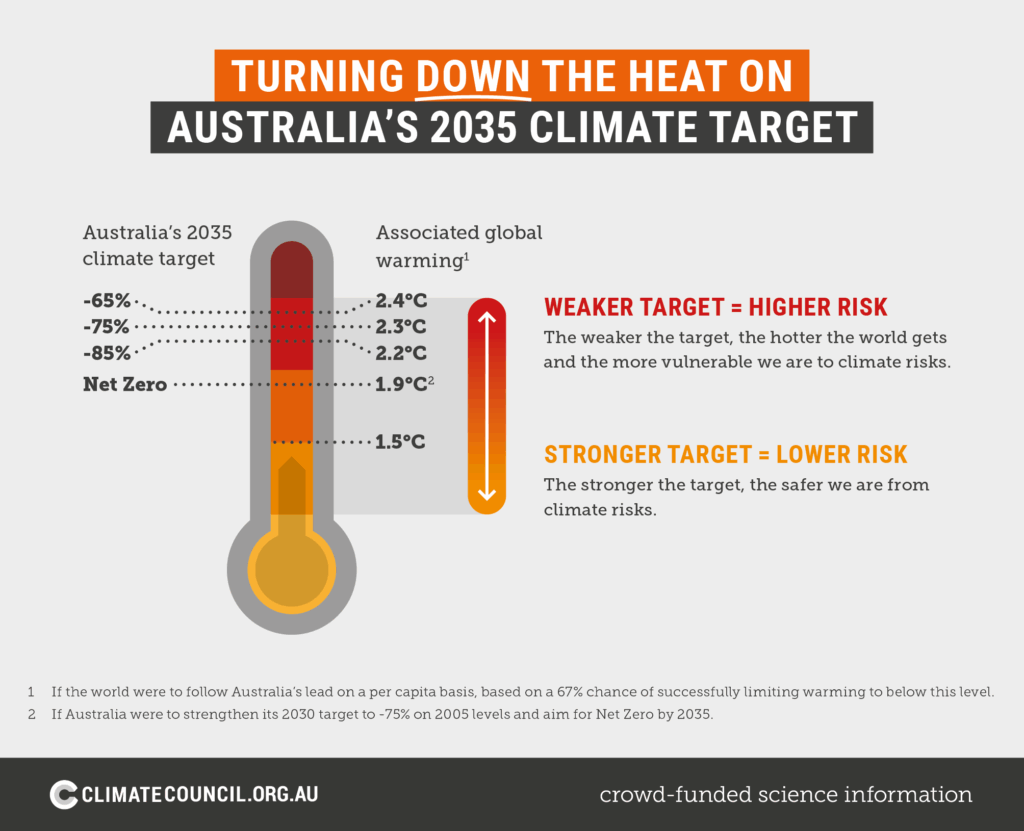NEW CLIMATE COUNCIL ANALYSIS reveals a stark choice before the Australian Government as it considers plans to cut climate pollution.
One of the Albanese Government's first - and most important - tasks in this new Parliament is to set a new Nationally Determined Contribution (NDC), or climate target, for 2035 once advice is received from the Climate Change Authority.
The Climate Council report, Stronger Target, Safer Future: Why Australia's 2035 Climate Target Matters, shows a strong national target can protect Australians from climate harm, open economic opportunities in modern industries like green metals and renewable power, and enhance our regional security.
Climate Councillor, Professor David Karoly said: "The scientific warnings in this report are stark and urgent. Australia's 2035 climate target must be as strong as possible to limit global warming to well below 2°C. Anything less will result in catastrophic climate consequences, like more frequent and intense heatwaves, floods, and dangerous bushfire weather with more lives lost. The stronger the emissions reduction target, the safer we are from climate risk.
"The longer we delay genuinely deep and sustained cuts to climate pollution, the harder it becomes to protect communities from escalating climate impacts. That's why we must do everything we can, as fast as we can to protect people and the places we love."
Climate Council's 'Stronger Target, Safer Future' report finds:
- Strong targets are essential to protect Australians from worsening climate harm, open economic opportunities in clean industries, and enhance our security relationships in our region.
- Weaker targets are aligned with higher levels of global heating. Each fraction of a degree of global heating is associated with more catastrophic impacts to communities and ecosystems.
- Global governments, business and scientists agree that holding global warming well below 2°C is vital to prevent massive disruption to the global climate system. Net zero by 2035 is the only target available to Australia with a strong chance of contributing to holding global warming below 2°C. This reduction curve is now very steep given Australia's pollution intensive economy and decade(2013-2022) of political delay.
- The cost of cutting climate pollution is dramatically less than unchecked climate change, which would cost Australia $4.2 trillion by 2070. Choosing a strong target now is far more cost-effective than attempting to adapt to escalating climate damage.
*Assuming other countries adopt the same per-capita share of the global carbon budget.
Climate Council CEO Amanda McKenzie said: "Australia was late to tackling our climate pollution after a decade of inaction from 2013-2022, so a science-aligned reduction curve is now steep. Yet the strength of the 2035 climate target set by the Albanese Government will shape the future of every Australian.
"With every fraction of a degree of global heating, we can expect more deadly climate disasters. Already this year, Australians have faced destructive flooding in New South Wales and Queensland, drought in South Australia and Victoria, and devastating marine heatwaves across three states. A strong 2035 target, with clear plans to meet it, is vital to protecting vulnerable communities from further climate harm.
"A weak climate target is not a passive choice. It's an active commitment to global climate disruption and damage. Those who advocate for weak targets must articulate clearly their costed plans to support, relocate or protect the Australian community through unprecedented social and economic breakdown.
Climate Councillor and economist Nicki Hutley said: "A strong climate target opens economic opportunities for Australia, driving great investment in cleaner energy sources, cleaner buildings and cleaner transport.
"The cost of climate action is dwarfed by the cost of unchecked climate change, which would cost Australia trillions in the coming decades. Choosing a strong target now is far more cost-effective than attempting to adapt to escalating climate damage.
"Setting a credible climate target also sends a clear signal to investors and industry. A strong target can accelerate growth in clean energy and green exports, which could be worth up to $1 trillion per year by 2050, creating over 400,000 jobs."







